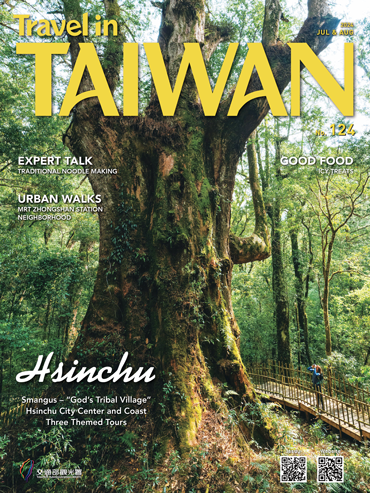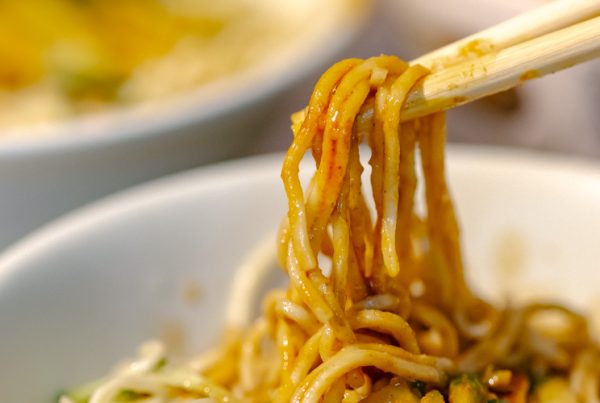One of the Best Tourist Attractions in Taoyuan
TEXT / TWELLI
PHOTOS / CHEN CHENG-KUO
Shimen Reservoir in Taoyuan City, once the largest reservoir in the Far East, is a remarkable site. It was one of Taiwan’s great industrial achievements of the post-WWII era, greatly improving the lives of farmers in the island’s northwest. It also became one of the most popular tourist attractions in Taoyuan, to this day drawing large numbers of visitors each year, including many who come to explore the dam, the manmade lake, and their surroundings on bicycle.
The “Shimen” (lit. Stone Gate) in the name of the reservoir refers to the location where the huge concrete dam was built to block the waters of the Dahan River. This is where the river, which originates high up in the Xueshan Mountain Range, leaves the mountains and flows along the eastern edge of the Taoyuan Plateau, from where it then makes its way north to the greater Taipei area and out to sea. The original purpose for creating the reservoir was to improve irrigation for farm fields on the plateau, especially during the dry season (November through April), prevent flooding during the rainy season (early summer to early autumn), supply residents of northern Taiwan with tap water, and generate electricity. Apart from these initial important functions, over time the reservoir also became an attractive day-trip destination for domestic as well as international travelers.
Reservoir Trivia
– Construction took 9 years
– 2,000 people had to be displaced
– 7,500 people took part in the construction
– Reservoir is 16km long
– Dam is 133m high and 360m long
– Because of silting, depth of reservoir is only 40m (down from 100m in the early days)
Content
Below the Dam
Riding a bicycle around Shimen Reservoir is a popular activity with day-trippers. There used to be a Merida bike-rental shop just outside the reservoir’s main car park, but operations were ceased some time ago. Time will tell if operators will set up shop again in the future, once domestic travel picks up momentum after the pandemic.

If you don’t have your own bike (and vehicle to get it to the reservoir), you can consider renting a YouBike public bike from docking stations that are, unfortunately, not in the immediate vicinity of the reservoir and require a ride of about 4km (nearest station) to the dam. For locations of the docking stations, check the station map on the YouBike website (www.youbike.com.tw) or app. If you take a bus on the Taiwan Tourist Shuttle’s Shimen Reservoir Route (No. 503; operates on weekends only), which launches from Zhongli Bus Station, you can get off at the Shihmen Reservoir Administration (Shihmen Grass Land) bus stop and rent a YouBike from one of the two docking stations close by.
When approaching the reservoir via Provincial Highway No. 4, you’ll first see a smaller dam just below the highway bridge that crosses the Dahan River. This is the After Bay Weir, which has the important function of keeping the water in check that comes rushing down from the main dam into the After Bay, ensuring that it runs smoothly downstream without damaging the riverbanks and the highway bridge.

From the main Shimen Reservoir parking lot, just beyond the toll gate (tickets are NT$80/car; free entrance for bicyclists), you can ride your bike across the weir and take a look at the After Bay to the left and the highway bridge to the right. After reaching the far end of the weir, follow the road on the west bank of the After Bay a bit further. There is the simple Fude Temple (dedicated to the Earth God) here, facing the main dam in the distance, and you will also pass the Near Water Café on your right-hand side (see end of article).
Note: At time of writing the weir was closed due to Covid-19 restrictions.
On returning to the car park area, turn right and ride along the east bank of the After Bay. You’ll soon come to the Nanyuan Eco Park, a spacious green area with boardwalks across artificial ponds, rest pavilions, and outdoor installation artworks. There are a number of interesting decommissioned materials from the dam facility on display, including sections of a large metal fence used to catch floating wood in the reservoir and a giant section of water pipe (4.57m in diameter) that was part of the dam’s power plant. Walk inside and clap your hands to hear a loud echo.


Coming closer to the dam, you’ll clearly see the power plant on the opposite side of the bay in the shadow of the giant wall of concrete.
While crossing at the bottom of the dam, you’ll pass the point where water is released from the reservoir in spectacular fashion during times of heavy rainfall. The release is known in Chinese as xiehong (lit. “flood discharge”).
To get to the top of the dam and the reservoir behind it, ride all the way back to the parking lot near the toll gate, then turn right onto Huanhu Road, the main access road to the dam. While climbing this uphill road through lush forest you’ll pass a popular nature park on the steep hillside, Xizhou Garden. The mountain behind is Mt. Xizhou, a great area for short hikes. From the car park to the dam it’s about 1.5km, and it can take up to 20 minutes to ride up the steep road.
Shortly before reaching the dam, you’ll pass a row of restaurants serving fresh fish from the reservoir, known in Chinese as huoyu (lit. “living fish”). Among the fish on the menus are various types of carp, including black carp, bighead carp, grass carp, and goldfish, prepared in a variety of ways, such as steaming, stir-frying, and deep-frying. Meals are typically multi-course affairs for groups seated around round tables.
On and Behind the Dam
Beyond the restaurants, to the left you’ll see a gray-facade building housing a visitor center, and the dam comes into view on the right-hand side. From the top of the dam you can enjoy marvelous vistas. Look down and take in the view of the After Bay, the weir, the highway bridge in the distance, and the Taoyuan Plateau beyond.
On the other side you’ll see the calm greenish waters of the reservoir and the beautiful verdant low mountains framing this artificial lake. At the mid-section of the dam is a Chinese-style pavilion, and behind that a small hill with an observation terrace and another pavilion. Walk up the stairs for excellent views of dam, reservoir, and far beyond from higher up. The hill is fittingly named Daba Songtai (lit. “Big Dam Lofty Platform”).

Reaching the far end of the dam, you’ll see a small tower at the center of a roundabout inscribed with four Chinese characters, Shi Men Sheng Jing (lit. “Shimen Winning Scenery”). This is a popular place for visitors to take pictures. If you have an interest in learning more about the history of Shimen Reservoir, you can find more information and old photographs inside the Yi Shan Ge building (Shimen Reservoir Museum) right beside the roundabout. Next door is the Yi Shan Ge café; buy a coffee there or a light meal (they sell soy-braised foods, luwei), sit on the plaza outside (weather permitting), and enjoy the reservoir scenery.

Shimen Reservoir is well known for its many maple trees, the leaves of which turn a beautiful red and brown during the winter months. If you visit during this time of the year, continue a bit further along the road past the tower and you’ll come to a particularly beautiful maple tree grove. The “maple leaf” (fengye) trees you’ll see in Taiwan are mostly green maple (acer serrulatum) and Taiwanese sweet gum (liquidambar formosana), the latter of which is in fact not a maple tree, despite its maple-like leaves. Another excellent spot to enjoy the foliage is the Xizhou Garden mentioned above.
Amuping Marina
After returning to the eastern end of the dam, you can continue your ride along the northern bank of the reservoir. The gently ascending, curvy road there takes you to some picture-perfect spots from where you can take in the reservoir and mountain scenery.
The scenic road goes all the way to the Amuping Marina (8km from the dam) and, further on, to Provincial Highway No. 7 (Northern Cross-Island Highway). There are numerous cafés along the way where you can stop for a rest.
If you don’t want to ride that far, you can get to the mid-section of the reservoir by boat instead. Touring yachts launch from the marina close to the dam. A one-hour lake cruise takes you past a number of scenic spots, including Longzhuwan (lit. “Dragon Pearl Bay”) and Menghuan Pingyuan (lit. “Dream Grass Plain”). From Amuping Marina, you can also take lake cruises to the opposite shore (“Ginger Island”; incl. a 30-min. land excursion) and even further up the reservoir (water levels permitting), as far as the Xikou Suspension Bridge.

Note: At time of writing, yacht cruises were suspended as part of Covid-19 restrictions.
Near Water Café
If, after exploring the reservoir, you are looking for a quiet place to sit down for an afternoon tea/coffee and/or light meal, consider the aforementioned Near Water Café on the west bank of the After Bay. (If the After Bay Weir should be closed to visitors at the time, you can reach the café via a side road off Provincial Highway No. 4, a short distance west from the highway bridge.) Inside a European-villa-style three-story building, the café has large windows with excellent views of the After Bay and the dam. The design is simple modern chic with comfortable leather chairs. On the second floor is a more basic cafeteria-style area perfect for visitors who come in groups.

Opened in October 2019, the café is best known for its superb location close to the reservoir. Outside is a small garden and a patio with potted cactuses, adding to the private-home feel of the place. The coffee served is of the finest quality. If you are particular about your brew, you can opt for drip-coffee selections, including Yirgacheffe, Kenya AA, and Elida beans. Pair this with fine fruit tarts (try the delicious blueberry and lemon tarts!) and waffles. If you’ve worked up an appetite from the biking around Shimen Reservoir, the café has also delicious light set meals on the menu, such as Garlic Chicken Thigh, Tonkatsu (Japanese-style pork cutlet), and Matsuzaka Pork.

Near Water Café (尼爾瓦特Café)
Add: No. 105, Lane 690, Daping Section, Longyuan Rd., Longtan District, Taoyuan City
(桃園市龍潭區龍源路大平段690巷105號)
Tel: (03) 471-2192
Facebook







